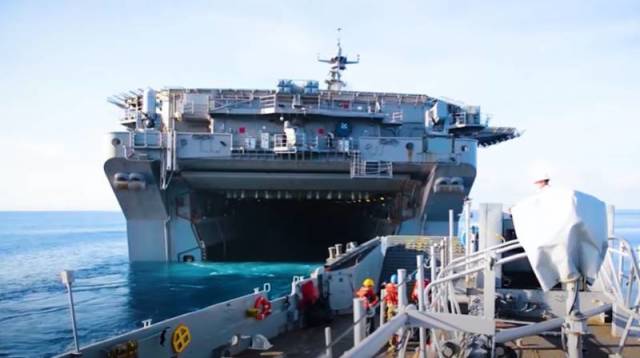
Image source: topwar.ru
The issue with landing ships in the United States is quite acute. In order for the reader to better understand the essence of the problem, it is worth explaining. The Congress and the Pentagon dislike the Marine Corps, because, according to American law, the president has the right to use the ILC at his discretion, without Congressional approval. Congressmen really don't like this, so Marines are always kept "in the black", they receive weapons and equipment almost always last.
The situation is similar with landing ships. The commander of the corps demands more amphibious ships, the admirals are against it, because the construction of the UDC "tears off" money from other naval programs. The Navy wants to write off two old "Islands" because their service life is already about 40 years, but Congress does not allow it, because there is nothing to replace.
The eighth ship of the "San Antonio" type has "hovered" so far. The construction of the "America" series is also going with a big "creak". These ships should replace two types of Iwo Jima and Tarawa at once, which have already been decommissioned. However, in addition to political and financial, there are also technical difficulties. Admirals and generals will not decide on the functionality, and therefore on the design of the ship.
The first two ships, America and Tripoli, conventionally Flight 0, were built without dock chambers to allocate more space for aviation and
l/s of the Marine Corps. However, practice has shown that they are needed, and the third ship, the Bougainville, Flight 1, is already being built with a dock chamber. Fallujah, respectively, too. Both pilots and Marines do not like this, because they had to reduce the volume of the corps that was allocated for their needs. The full-time landing capacity has been reduced from 1,686 to 1,462 people. The more compact Iwo Jima could carry 1800 Marines in the "overload". The ILC does not like this situation, because more ships are needed to transfer the expeditionary battalion.
Aviators are not happy about the fact that the amount of aviation fuel has decreased due to the installation of ballast tanks to fill the dock chamber. Less powerful gas turbine engines were installed, the maximum speed decreased to 21 knots. Although for the convenience of the air group, a third deck lift is installed on the Fallujah, unlike the two onboard ones on the first three ships. It is assumed that these ships will be able to perform the functions of a light aircraft carrier, the number of F-35s is brought to 20 pieces. But, as already mentioned, the small amount of jet fuel, still reduced on the third and fourth ships, makes such an application unlikely. The F-35 in vertical takeoff and landing mode consumes jet fuel in huge quantities. True, the designers claim that horizontal takeoff is possible on the Bougainville and Fallujah due to the lengthening of the flight deck, but due to some reduction in fuel or used fuel.
A total of 12 ships of this type are planned to be built. However, the program is already very far behind schedule. "America" was supposed to enter service in 2012, but it happened only in 2014. According to Tripoli, the situation has become even worse, according to the plan, it was supposed to "become operational" in 2017, but this happened in 2020. According to the Bougainville, the situation worsened even more: it was supposed to be handed over to the fleet in 2019, but it was only laid in 2019. Fallujah was also supposed to be laid in 2019, but this has only happened now. Although the hull is already in a fairly high degree of readiness, the condition of other ship systems is not known. The average cost is $2.4 billion. Although taking into account inflation and the rise in the cost of systems and weapons, the cost will grow.
